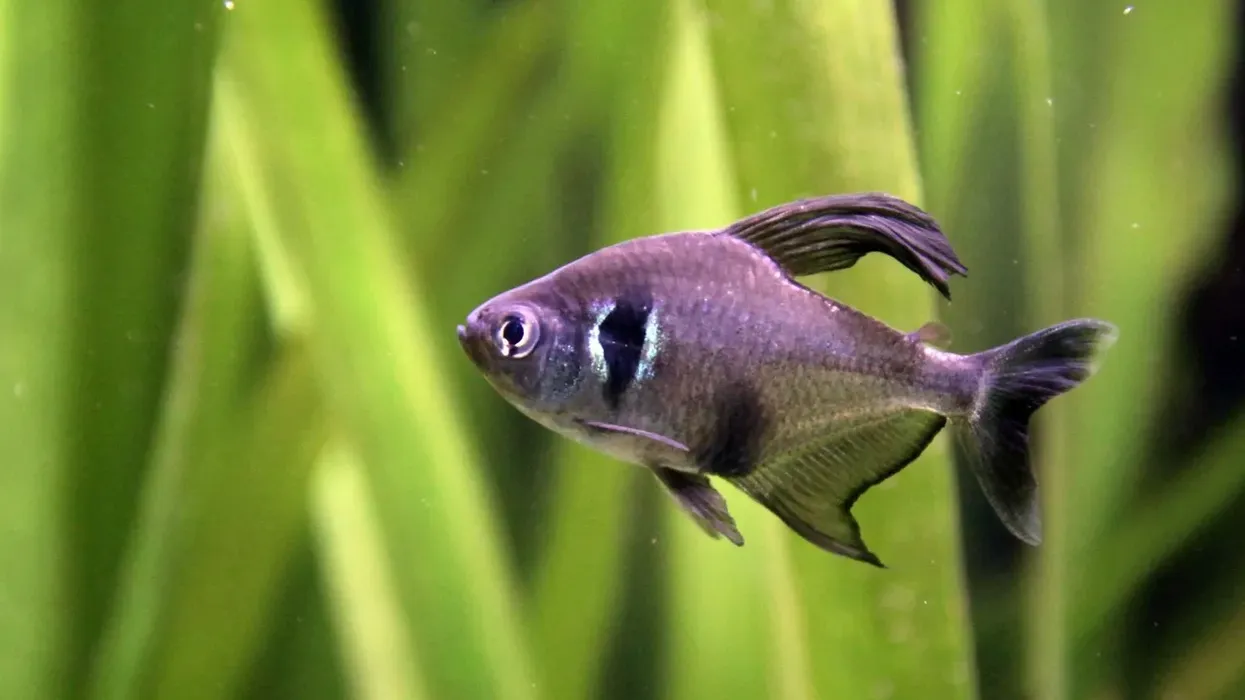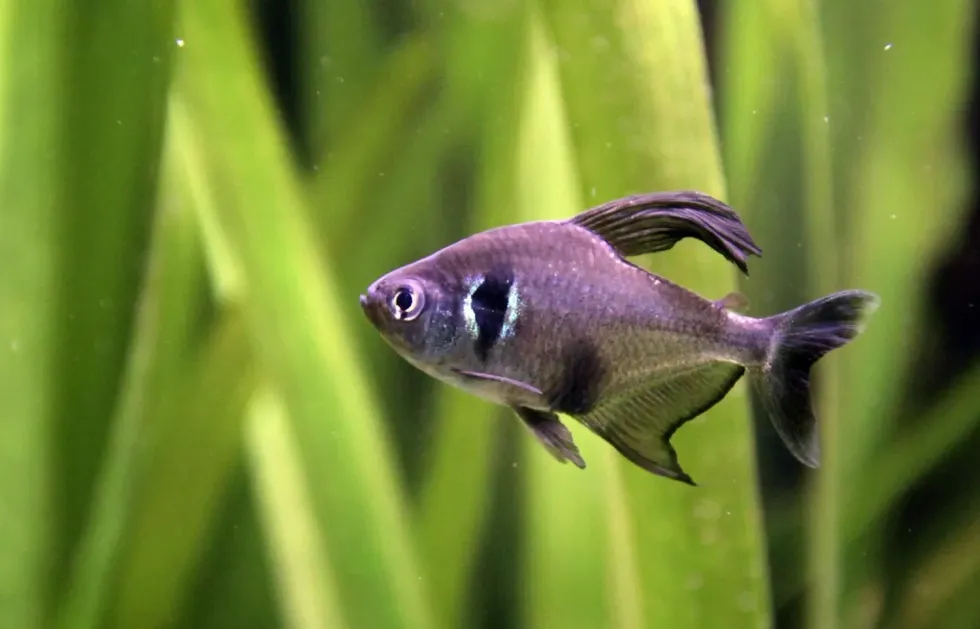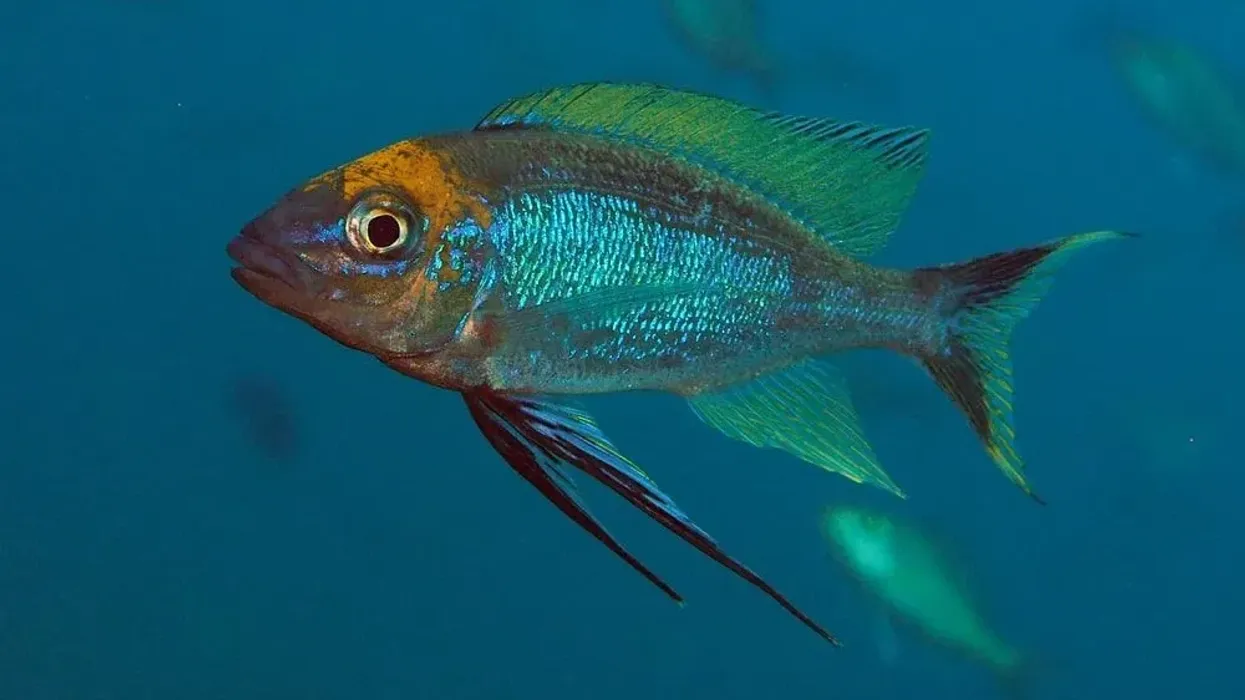Black phantom tetras are a peaceful fish species ideal for community tanks. They are very social and can deal well with most types of tank mates.
Just be careful if you keep them with aggressive fish as they can feel quite threatened that way. Trouble can also follow if more than one male is kept in the same tank, as they can get into territorial battles that might end up in fin-nipping.
No fish is seriously harmed in these fights, though, thankfully. Many interesting facts are surrounding these fish, we suggest you keep reading on to find out.
If you like reading these articles, please check out our similar ones on the black neon tetra and the tetra.
Black Phantom Tetra Interesting Facts
What type of animal is a black phantom tetra?
A black phantom tetra is a type of freshwater fish, native to Brazil and the northern part of Paraguay. They are mostly carnivores, their diet consisting of a variety of worms, and shrimps. They are a very peaceful species, making them an ideal choice for a lot of different kinds of tank mates.
What class of animal does a black phantom tetra belong to?
The black phantom tetra is a freshwater fish species known for its distinctive patch of black behind its gills, belonging to the class Actinopterygii. They look almost like a human eye, giving them a unique look.
Like all other tetras, they are very easy to keep and very entertaining to watch. If you are lucky enough, you can even witness the males participating in mock battles with each other. No reason to worry, though as these fights are completely harmless.
How many black phantom tetras are there in the world?
It is hard to say just how many black phantom tetras are there in the world, as they are not listed as a species of concern on the IUCN red list.
This gives us hope that as of now, there is no reason to worry over the future of these fish and that they are thriving in their natural habitats.
Where does a black phantom tetra live?
These fish originate from the freshwater rivers of Brazil in South America.
What is a black phantom tetra's habitat?
These fish are avid swimmers and prefer slow-moving and murky waters dense with vegetation. If you are keeping them in a tank remember to keep the temperature between 72-82 F, as that will make them contented enough to show some of their natural behavior.
The black phantom tetra care is a very easy routine to follow and you can include most types of foods into their diet.
Who do black phantom tetras live with?
The black phantom tetras are a type of fish known for often living in large groups consisting of numerous individuals. They are also very easy to keep and are preferable for community aquariums.
This is why they are a fan favorite among fish keepers nowadays. However, when choosing tank mates for them, you need to keep in mind not to put them in with particularly aggressive fish species, as they are very peaceful and can be threatened by aggressive fish.
How long does a black phantom tetra live?
The life span of the black phantom tetras is known to be about five or six years. You can decorate the bottom of the tank with dark gravel and floating plants to give them a taste of their natural surroundings. This will not only make them more comfortable but the dark background will also bring out their beautiful coloration.
How do they reproduce?
These fish are known to be pretty prolific. On average a female fish can lay about 300 eggs.
You can help the breeding process by placing a chosen breeding pair in a separate breeding tank and decorating it with plants. The body of the females becomes noticeably plumper during this time and the coloration of both species becomes much more prominent.
You can also provide them with live food as well as good quality flake food. The temperature of the tank should not be less or more than 72-82 F. Breeding them is pretty easy and you can see the eggs by the next morning.
What is their conservation status?
They are listed as a species of Least Concern on the IUCN Red List. They are very compatible with community aquariums, provided that their tank mates are of a non-aggressive kind, as aggressive fish could potentially harm these peaceful species.
Although the males are known to have mock battles between them, they never really harm each other. Just keep in mind, that when they are kept in tanks, the tank size should ideally at least be 10 gallons.
Black Phantom Tetra Fun Facts
What do black phantom tetras look like?

The bodies of black phantom tetras are flat and almost oval. The adipose fin, anal fins, and dorsal fins of the males are black, and while the dorsal fins of the female black phantom tetra are the same, the other portions vary in color.
The anal and adipose fins of the females are reddish. The males tend to have longer fins than the females, and their black color becomes more prominent during the breeding season.
The females become noticeably plumper during this time and the red on their fins also becomes more noticeable. There is another long-finned variation of the black phantoms bred by captive breeders that are sold in the fish-keeping trade.
How cute are they?
The black phantom tetras are very cute with their iridescent bluish-white and silver scales, and the black phantom eye patch black and red fins. Some captive-bred variants of this species are known to be long-finned, which gives them more of an exquisite look.
How do they communicate?
A peaceful, yet interesting species of fish is the black phantom tetra. Hyphessobrycon megalopterus is their scientific name.
Their communication habits are also interesting, mostly conveying their intent through bodily gestures.
The males often participate in mock battles, which, if you are lucky enough, you will get to see if they are kept in a tank with more than one individual of their species. These mock battles are completely harmless though.
Mostly, the males flare their dorsal and anal fins and turn a darker shade of color when they are about to participate in a fight.
No fish are harmed during this, but if you want to avoid these altogether, do try to invest in a longer tank of about 10 gallons and 20 inches in length. They are very peaceful which makes them a great choice for a community tank as well as for people who are new to fish keeping.
How big is a black phantom tetra?
These fish are very small averaging at about 1-1.4 in (2.5-3.6 cm) in length, which is about the same body size as a small Panamian golden frog.
How fast can a black phantom Tetra run?
We cannot say how fast they can run, but they are known to swim pretty well, but as they are pretty small in size, their average speed is probably quite slow!
They do, however, need a pretty long tank to be comfortable because if there is more than one male present in a single tank mock battles can break out between them over territory.
How much does a black phantom tetra weigh?
It is hard to say just how much they weigh as they are pretty much tiny in size, and, well because it is kind of hard to weigh a live fish out of the water.
However, they are avid swimmers and need space to explore and swim around their tank, which you can decorate with plants, dried leaves, river sand, and gravel on the substrate.
What are the male and female names of the species?
The males and females do not have sex-specific names. The male tetra fish are known simply as male black phantom tetra and the female fish are known just as female black phantom tetra.
What would you call a baby black phantom tetra?
The babies of the black phantom tetra fish are called fry. The black phantom tetras are known to be an egg-scattering species, and the females are known to produce about 300 eggs per clutch.
What do they eat?
Black phantoms are known to eat a variety of different types of insects and worms. Along with eating lobsters, krill, brine shrimp, crabs, crayfish, barnacles, prawns, woodlice, and blood worms, they are also known to eat mosquito larvae and other live foods.
High-quality flake food is another thing that you should include in the diet. Live food and high-quality flake food are especially recommended for feeding breeding pairs.
You can also help this process by keeping them in a separate breeding tank decorated with floating plants or plants that are common to their natural habitat. It will give the tank a darker background and make the color of the black phantom tetras more noticeable.
Are they dangerous?
They are very small and very peaceful. They are not even dangerous to each other fish, let alone humans.
They can, however, be threatened by more aggressive fish if kept in the same community tank. So, the ideal tank mates for them would be fish that are as peaceful as they are.
It will not only keep the environment in the tank safe for everyone, but you might also get to witness some of their interesting natural behavior that you might otherwise miss out on.
Would they make a good pet?
They make amazing pets for all kinds of owners but, especially for new ones. The main reason for that is these fish are very peaceful and the black phantom tetra care is one of the easiest routines to follow.
They eat pretty much everything, so feeding them is not a demanding job, although you will have to feed them a few times a day.
They might also end up eating their eggs, so that is something you need to be careful about.
Their tank should also be a little longer as they are avid swimmers and tend to need their space for exploring. Other than these things, they are peaceful yet very interesting to watch, and the reason why they have become so popular in the fish tank-keeping community.
Did you know...
Feeding them is very easy as they are omnivores in diet and tend to eat a variety of things.
Are Black Phantom Tetras aggressive?
These fish are one of the nonaggressive fish out there. These make them a perfect match for a community tank, along with the fact that they eat almost everything from freeze-dried to live food, and even flake foods, which makes feeding them very easy.
No wonder they have become one of the more favored fish in the fish tank-keeping community. They can however participate in mock battles with the males of their species if the tank is too small, but even in these cases, no fish are harmed.
Are Black Phantom Tetras fin nippers?
Yes, they are fin nippers, but thankfully this is not something that occurs frequently. They are very calm, except if they are trying to defend their territories. No serious damage is suffered by any fish during these fights.
Here at Kidadl, we have carefully created lots of interesting family-friendly animal facts for everyone to discover! Learn more about some other fishes including the vendace fish and the African lungfish.
You can even occupy yourself at home by drawing one of our Black Phantom Tetra coloring pages.










